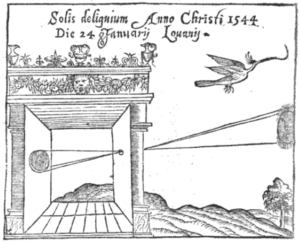Don’t have eclipse glasses but still want to see the eclipse? We’ve got you! With just a few simple supplies, you can create a pinhole camera viewer to see the eclipse safely from anywhere.
Moody College of Communication journalism professors Donna De Cesare and Raymond Thompson Jr. show you how to quickly assemble a pinhole camera viewer to see the April 8 total solar eclipse.
What is a pinhole camera?
Before photography, our human ancestors noticed that, when standing in a dark chamber with a small round opening for light, you could see an upside down image of the world outside.

In 1544, Dutch scientist Rainer Gemma Frisius used a camera obscura, the Latin words for “dark room” to project an image of the solar eclipse.
In the 18th century, the desire to make these images permanent, along with developments in chemistry, evolved into the first photographic cameras.
“If the idea of time travel fascinates you, this is a really fun way to safely see the eclipse the way our ancestors did,”
Don’t have time to put together a pinhole camera? Simply take a colander with multiple holes in it and hold it up to the eclipse — be sure to face away from the sun. You’ll see multiple projections of the eclipse on the ground. It’ll make a great photograph!
If you do make a pinhole camera viewer, tag us on social media and we’ll share it. Have fun, and remember to always protect your eyes and your camera sensor!



